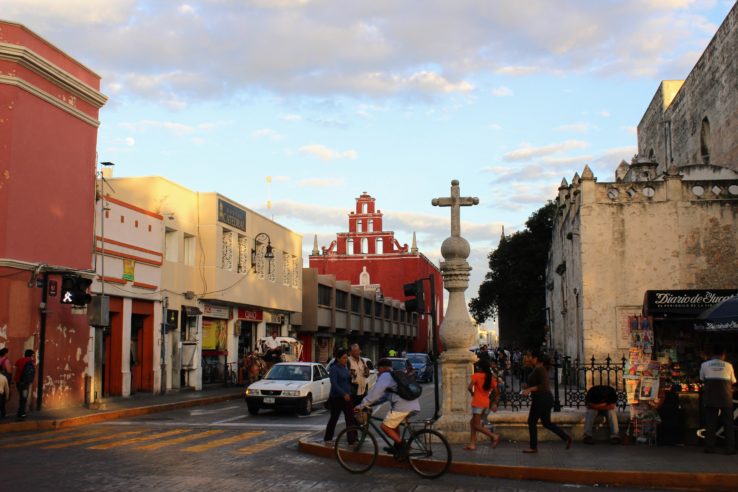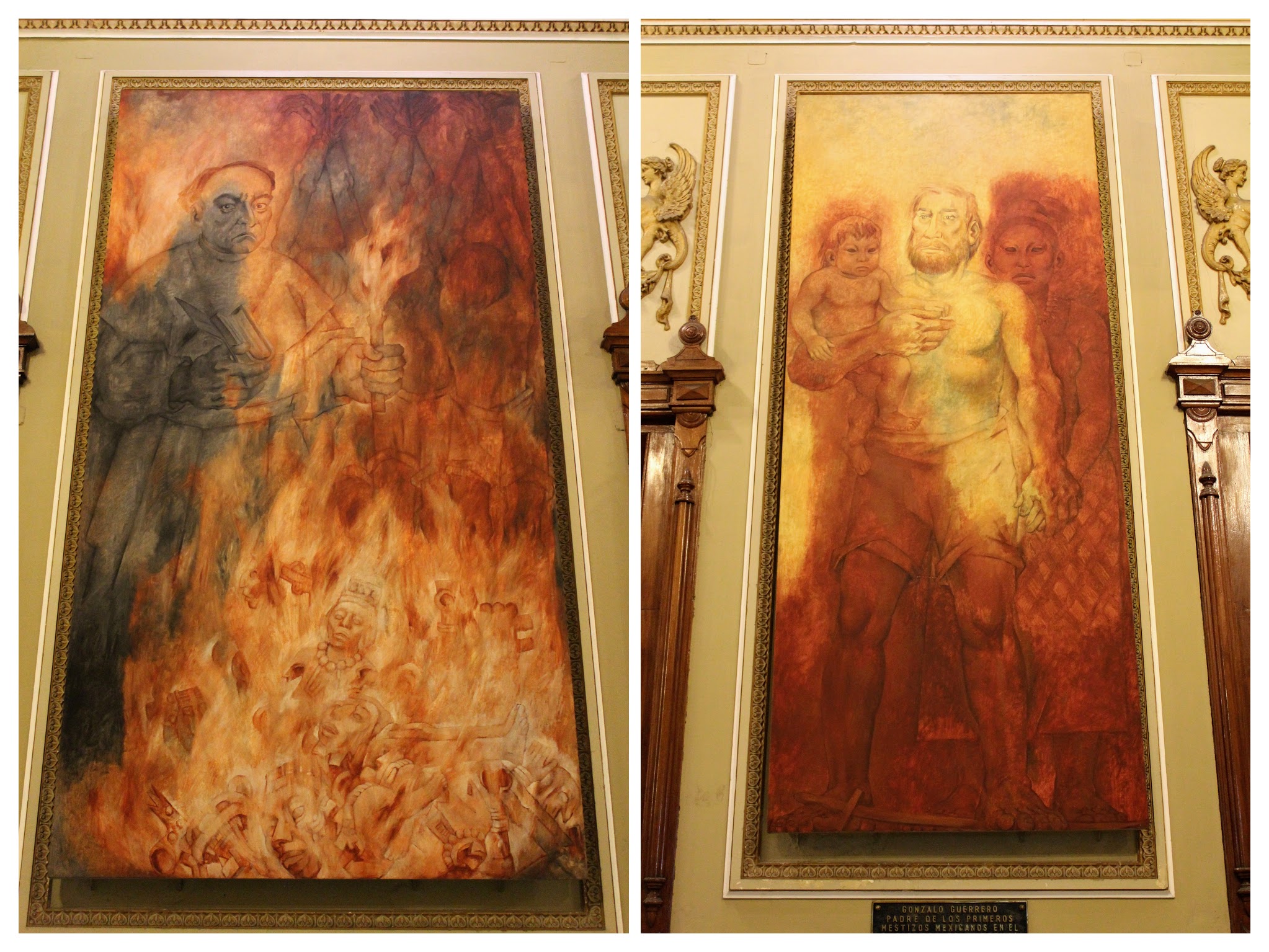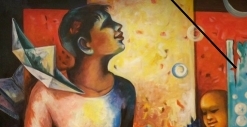After 2 months in Guadalajara, coming to Mérida was almost like visiting another country. Different people, different food, in some places even signs in a different language. On our way from the airport, the driver was telling me that his father is Maya while his mother is a mestizo. “Did your father speak Maya with you?”, I asked him. “No, my mother wouldn’t let him speak Maya in the house”.

The Maya people, the descendants of the same people who built the pyramids, make up the main indigenous group in Yucatan, and 700,000 of them still speak Maya.

Here is another thing you suddenly see on every corner: hammocks. They are everywhere, in houses, on merchants shoulders and even as a decorative element on ceilings.

Food must be the most resilient cultural attribute of people. You can take away their religion, their language, their customs, but you can’t take away what they are used to eat. After 500 years of European domination, in Yucatan, maize, frijoles (beans) and chilli peppers are still the most important ingredients, present in some form in almost every dish.
In Gorditas Doña Gorda, just near the central square, tortillas are prepared on spot. They are called here gorditas (“little chubbies”), because unlike regular tortillas which are basically flatbreads from maize, gorditas are thicker, and are filled with meats, beans and other fillings. One gordita is around 50 cents. We took home six, all with different fillings, and they were all delicious.

While the Maya culture is preserved in food, crafts and the syncretism of the local catholicism, the Spanish left their mark on the city in its architecture.

Built on the site of a destroyed Maya city, the spanish planned it according to their usual preference: A grid of straight lines with a large square in the center.

Let’s admit it, there is nothing that says Spanish architecture better than… urns.


Casa de los Montejo is one the oldest spanish buildings in Merida, built in 1540’s by the conquistadors of Yucatan – Francisco de Montejo, his son and his nephew who was the one who finished the conquest his uncle started.
The entrance to the house is free. Inside, rooms decorated in victorian style tell the story of the mansion throughout the centuries.
On the other side of Plaza Grande stands Merida’s cathedral, the first one to be finished on the American mainland.
The distinct white chairs facing each other are spread throughout the city and render it a unique visual appeal.
Late in the 19th century and the early 20th Century, the area surrounding Mérida prospered from the production of henequén,a variety of the agave cactus used to produce rope which was exported for the booming shipping industry. For a brief period, around the turn of the 20th century, Mérida was said to house more millionaires than any other city in the world.
The result of this concentration of wealth can still be seen today. Many large and elaborate homes still line the main avenue Paseo de Montejo, though few are occupied today by individual families
The government palace on the third side of Plaza Grande is a must visit, as much for its art as for the story it tells of Yucatan.

In the history of Yucatan, the Spanish bishop De Landa (in the below picture on the left) is a central figure, who has left a mixed legacy. On the one hand his writings contain much valuable information on pre-Columbian Maya civilization. On the other, he played a central role in the destruction of much of that civilization’s history, literature, and traditions.
On the right is Gonzalo Guerrero, a Spanish sailor who shipwrecked along the Yucatán Peninsula and was taken as a slave by the local Maya. Earning his freedom, Guerrero became a respected warrior under a Maya Lord and raised three of the first mestizo children in Mexico.
The plight and the suffering of the Maya under the Spanish rule is vividly portrayed in the works on the government palace walls. At first I surprised by this honest admittance of past sins. But then I realized that today’s elites do not associate themselves with the Spanish. Mexican independence allowed the privileged classes to distance themselves from the atrocities purported for centuries, without doing enough to make the lives of the disenfranchised Maya better.
On Monday evening I went to see the weekly Vaquería Yucateca, traditional Yucatan dances performed by older men and women near the municipality building.
The bottle dance seems to originate in the time of the conquest, when the Maya were made to put on their heads a bottle and dance, as an entertainment for the Spanish visitors and troops.
Pain and humiliation turned into pride. More than anything, Merida is a living, breathing testimony to the incredible syncretism of Mexican culture.





















What a wonderful introduction to the Yucatan. Have been many times, particularly a bit further south in San Pedro Belize which is about 60 km from Tulum. As to “Spanish Rule” if you are in Cuzco (Peru) you will see the impact on a culture (Quechen) by the Spaniards where their churches were superimposed over local important sites – with their fancy urns and large doors to keep the locals (in or out) of their grand churches.
Thanks Sid,
Cholula near Puebla is another such example of “superimposition” – а church built literally on top of a pyramid.
Looking forward to discover Peru ))
I live in Mérida, there are a lot of errors in this post. For example, “sopa de lima” is made with turkey, not chicken. Another quick one, UADY is la Universidad Autónoma de Yucatán, or “Autonomous University of Yucatan”
Thanks for the corrections. I think Sopa de Lima can be made with both, but maybe I’m wrong.
Very nice photos! I walk past many of these places several times a week and appreciate the careful selection and lovely coloring. Glad you like the gordita fillings as well! And yes, sopa de lima can be made with both.
Thank you,
glad you enjoyed the post. The gorditas were delicious, they remain one of my favorite Mexican foods 🙂
Great article!!
Thank you Patricia!
Good article and yes, the food here is amazing! Next time, go to Wayan’e to have some castakan con queso tacos. You will die. Of pleasure of course. 🙂
Just a small quibble, the elite you mention who do not associate themselves with the Spanish – the European component was/is very important throughout Mexico and far from disassociating themselves, the whiter elements of society are proud to not have any ‘indian’ blood in them. Here in Merida, and I suspect throughout the country, it was frowned upon for their children to fraternize with or – heaven forbid – have a romantic relationship with someone of the ‘indian’ class. The fine white folks of Spanish descent who worked the Mayans to death on their haciendas were not Spanish, but Yucatecans and their descendants live on, still rich, and still for the most part unwilling to shed their racist outlook on those who are brown and have Mayan surnames.
Thank you William for your thoughtful comment.
You are right, Mayans are still negated many of the opportunities that local “european” Mexicans have. But given that reality, I was surprised by the candid exhibition in the government palace. Don’t you think that at least partially, it’s an attempt to throw the blame to the Spanish (not that they weren’t to blame), and exonerate the Mexican elites?
The painter, Fernando Castro Pacheco, was decidedly pro-campesino and sympathetic to their plight at the hands of the elite. Did you notice how the facial expressions of the Mayans were almost noble, while those of the soldiers and others from the oppressor side of the equation were more simian? While the folks who reaped the benefits of the indian exploitation were of Spanish blood, they were most definitely Yucatecan, especially during the caste war and the henequen (sisal) boom. Anyway, thought provoking to be sure! Saludos!
Thank you William for the clarifications, lots of valuable insights!
I stumbled across your site while looking up Merida and have been binge-reading your travel posts all day! Fascinating reads indeed!
I and my wife plan to slow travel through Mexico and South America hopefully before too long, (I am 51). I find your travel accounts deep and informative filled with a genuinely unique manner of storytelling.
Thank you for sharing!
Thank you Sony for the comment, it’s always heart-warming to hear from a fellow traveler.
This year had derailed many plans, including travel ones. Hopefully, you’ll be on your way soon.
Feel free to sign-up to blog updates. I don’t post often: http://eepurl.com/cH8UEz